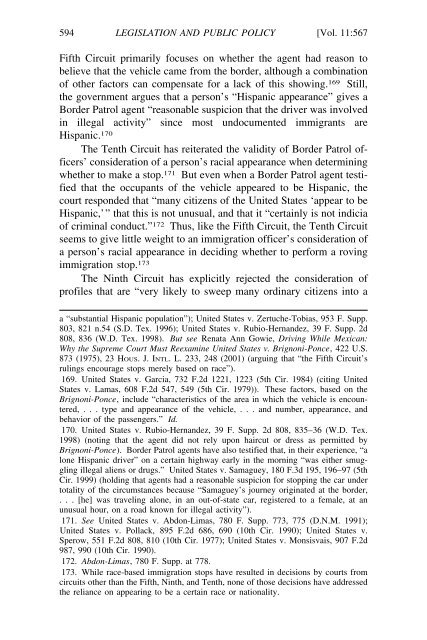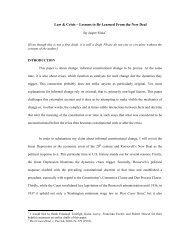updating brignoni-ponce - New York University School of Law
updating brignoni-ponce - New York University School of Law
updating brignoni-ponce - New York University School of Law
You also want an ePaper? Increase the reach of your titles
YUMPU automatically turns print PDFs into web optimized ePapers that Google loves.
594 LEGISLATION AND PUBLIC POLICY [Vol. 11:567<br />
Fifth Circuit primarily focuses on whether the agent had reason to<br />
believe that the vehicle came from the border, although a combination<br />
<strong>of</strong> other factors can compensate for a lack <strong>of</strong> this showing. 169 Still,<br />
the government argues that a person’s “Hispanic appearance” gives a<br />
Border Patrol agent “reasonable suspicion that the driver was involved<br />
in illegal activity” since most undocumented immigrants are<br />
Hispanic. 170<br />
The Tenth Circuit has reiterated the validity <strong>of</strong> Border Patrol <strong>of</strong>ficers’<br />
consideration <strong>of</strong> a person’s racial appearance when determining<br />
whether to make a stop. 171 But even when a Border Patrol agent testified<br />
that the occupants <strong>of</strong> the vehicle appeared to be Hispanic, the<br />
court responded that “many citizens <strong>of</strong> the United States ‘appear to be<br />
Hispanic,’” that this is not unusual, and that it “certainly is not indicia<br />
<strong>of</strong> criminal conduct.” 172 Thus, like the Fifth Circuit, the Tenth Circuit<br />
seems to give little weight to an immigration <strong>of</strong>ficer’s consideration <strong>of</strong><br />
a person’s racial appearance in deciding whether to perform a roving<br />
immigration stop. 173<br />
The Ninth Circuit has explicitly rejected the consideration <strong>of</strong><br />
pr<strong>of</strong>iles that are “very likely to sweep many ordinary citizens into a<br />
a “substantial Hispanic population”); United States v. Zertuche-Tobias, 953 F. Supp.<br />
803, 821 n.54 (S.D. Tex. 1996); United States v. Rubio-Hernandez, 39 F. Supp. 2d<br />
808, 836 (W.D. Tex. 1998). But see Renata Ann Gowie, Driving While Mexican:<br />
Why the Supreme Court Must Reexamine United States v. Brignoni-Ponce, 422 U.S.<br />
873 (1975), 23 HOUS. J. INTL. L. 233, 248 (2001) (arguing that “the Fifth Circuit’s<br />
rulings encourage stops merely based on race”).<br />
169. United States v. Garcia, 732 F.2d 1221, 1223 (5th Cir. 1984) (citing United<br />
States v. Lamas, 608 F.2d 547, 549 (5th Cir. 1979)). These factors, based on the<br />
Brignoni-Ponce, include “characteristics <strong>of</strong> the area in which the vehicle is encountered,<br />
. . . type and appearance <strong>of</strong> the vehicle, . . . and number, appearance, and<br />
behavior <strong>of</strong> the passengers.” Id.<br />
170. United States v. Rubio-Hernandez, 39 F. Supp. 2d 808, 835–36 (W.D. Tex.<br />
1998) (noting that the agent did not rely upon haircut or dress as permitted by<br />
Brignoni-Ponce). Border Patrol agents have also testified that, in their experience, “a<br />
lone Hispanic driver” on a certain highway early in the morning “was either smuggling<br />
illegal aliens or drugs.” United States v. Samaguey, 180 F.3d 195, 196–97 (5th<br />
Cir. 1999) (holding that agents had a reasonable suspicion for stopping the car under<br />
totality <strong>of</strong> the circumstances because “Samaguey’s journey originated at the border,<br />
. . . [he] was traveling alone, in an out-<strong>of</strong>-state car, registered to a female, at an<br />
unusual hour, on a road known for illegal activity”).<br />
171. See United States v. Abdon-Limas, 780 F. Supp. 773, 775 (D.N.M. 1991);<br />
United States v. Pollack, 895 F.2d 686, 690 (10th Cir. 1990); United States v.<br />
Sperow, 551 F.2d 808, 810 (10th Cir. 1977); United States v. Monsisvais, 907 F.2d<br />
987, 990 (10th Cir. 1990).<br />
172. Abdon-Limas, 780 F. Supp. at 778.<br />
173. While race-based immigration stops have resulted in decisions by courts from<br />
circuits other than the Fifth, Ninth, and Tenth, none <strong>of</strong> those decisions have addressed<br />
the reliance on appearing to be a certain race or nationality.
















